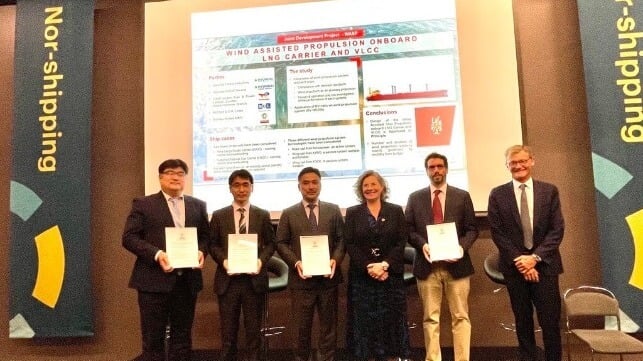Bureau Veritas Approves Wind Assisted Ship Propulsion for LNG Carriers


that matters most
Get the latest maritime news delivered to your inbox daily.
[By: Bureau Veritas]
Bureau Veritas (BV), a world leader in testing, inspection and certification, awarded an Approval in Principle (AiP) to Hyundai Heavy Industries Co., Ltd – Hyundai Global Service CO., Ltd (HHI), TotalEnergies Gas & Power Limited, and Mitsui O.S.K. Lines, Ltd. (MOL), for wind assisted ship propulsion (WASP) on a Very Large Crude Carrier (VLCC) and a Liquefied Natural Gas (LNG) carrier.
The AiP was presented at Nor-Shipping in Oslo, marking the successful completion of a Joint Development Project (JDP) between all four companies to better understand and validate the potential for WASP on these ship types. Matthieu de Tugny, President of Bureau Veritas Marine & Offshore, personally presented the AiP certificates to the representatives of HHI, TotalEnergies and MOL at the event.
The JDP focused on three wind propulsion technologies, two of which were wing sails and one a rotor sail system. The principal conclusion of the project and the subsequent issuance of the AiP demonstrate that all of these systems are compatible with existing classification rules and regulations for VLCCs and LNG carriers, thereby paving the way for more detailed work to address specific risks that would enable detailed design and arrangement work to proceed.
BV actively participates in multiple WASP projects, supporting the development of innovative technologies. In March 2021, BV released an update to its rule note for WIND PROPULSION SYSTEMS (WPS) – NR 206. Building on pre-existing BV rules released in 1987, the rule note provides the classification requirements for modern wind-powered ships. BV Rule Note NR206 provides load cases and coefficients for all types of wind propulsion technologies, including free standing rigs, wing sails, kite sails, suction sails, and rotors.
These dedicated rules serve as the key classification framework for wind assisted propulsion. Firstly, during the design review stage, the rules ensure the safety and proper integration of wind propulsion systems with other onboard systems. Secondly, throughout the vessel’s in-service life, the rules address survey regimes and maintenance requirements.
The products and services herein described in this press release are not endorsed by The Maritime Executive.
